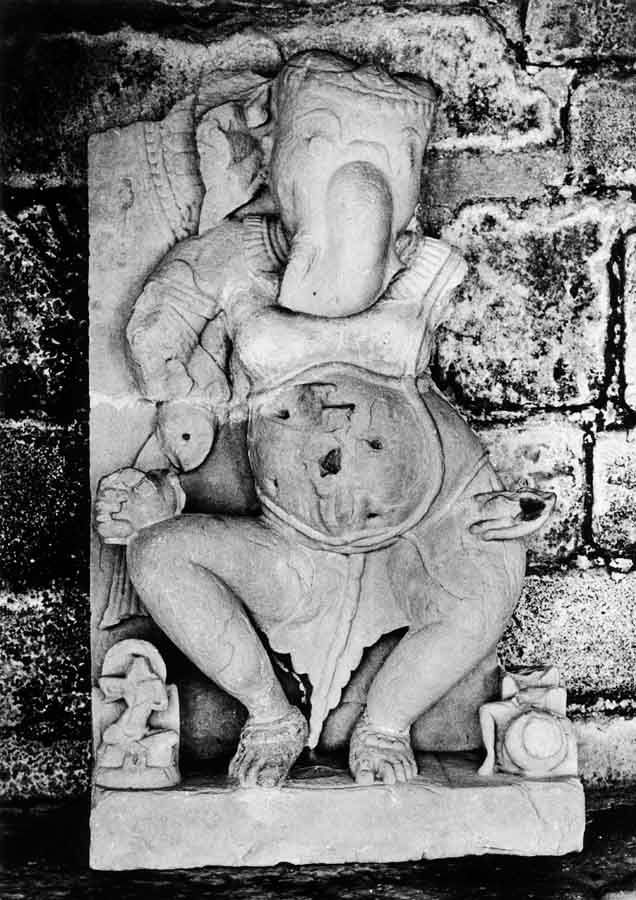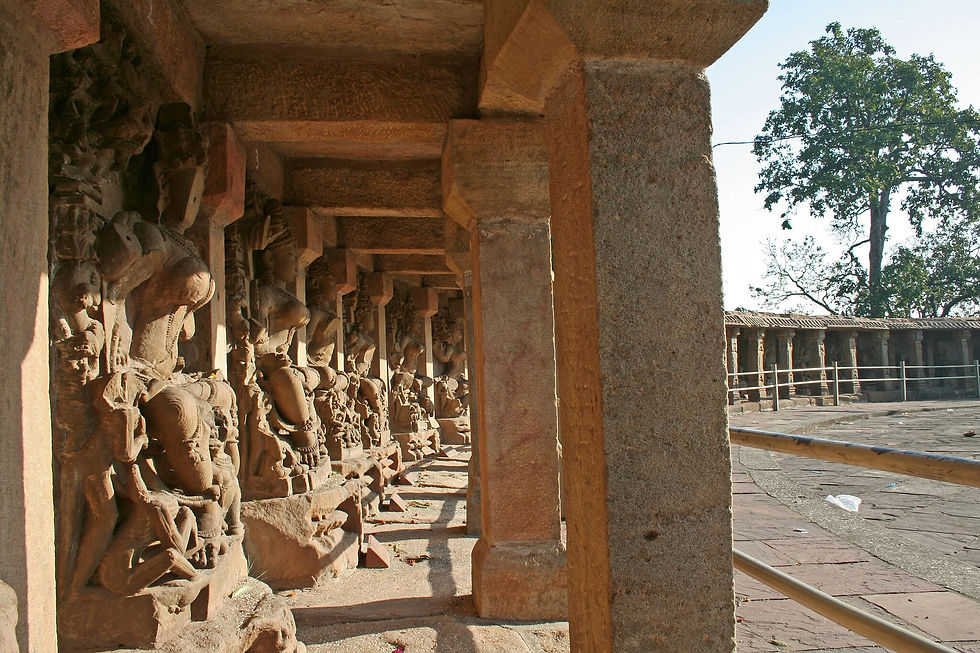The Hidden Goddess: The Mystery of Vainayaki
- Anu Writes 73

- Aug 28
- 5 min read
In the sacred landscape of Indian spirituality, where Ganesha reigns supreme as the beloved remover of obstacles, there exists a fascinating and largely forgotten divine feminine counterpart whose story has remained hidden in the shadows of ancient temples and medieval manuscripts. Vainayaki, the elephant-headed goddess, represents one of India's most intriguing examples of how divine feminine power was celebrated in ways that challenge our modern understanding of Hindu worship.

A Personal Journey: Rediscovering Vainayaki Before the Digital Age
Long before the Internet transformed scholarship and travel, the quest to uncover the secrets of goddess traditions of India required old-school perseverance. My research on the Shakti divinities in Madhya Pradesh unfolded in the pre-digital era, relying solely on reference books from libraries, journeys to remote sites, museum archives, and conversations with local experts and villagers. This immersive process meant countless hours poring over dusty manuscripts, scanning rare volumes in regional museums, and physically travelling to temples and archaeological sites in search of elusive images.
It was during this journey - while working on the mysteries of the Saptamatrikas (the seven Divine Mothers) - that I first encountered the enigmatic shakti of Ganesha known as Vainayaki. Most popular sources had little or nothing to say about her. But through archival research and field visits, I discovered tantalizing local stories and visual evidence. The moment of revelation came during my visit to the Chausath Yogini temple at Bhedaghat: faced with the stone sculpture of Vainayaki herself. That direct encounter, set amidst the circular sanctum ringed with powerful Yogini images, remains a defining experience in my journey as an art historian, grounded in tactile realities and nuanced conversations rather than digital data.

The Mystery of Divine Feminine Power
Vainayaki emerges from the mists of early medieval India as a powerful embodiment of Shakti, the divine feminine energy that the ancient traditions believed animated all of creation. Unlike the familiar narratives of mainstream Hindu goddesses, her story unfolds in the esoteric circles of Yogini worship, where 64 powerful female deities were revered in circular, roofless temples that dotted the Indian landscape between the 9th and 12th centuries.
She appears under multiple names across different traditions - Vinayaki, Vignesvari, Ganesani, Gajananā, Sri-Aingini - each reflecting regional and sectarian variations. This multiplicity itself testifies to her widespread veneration across Hindu, Jaina, and Buddhist contexts, each incorporating her into their unique theological frameworks.

Archaeological Treasures: Stone Sculptures That Speak
The earliest known image, a terracotta plaque unearthed at Rairh in Rajasthan, may be dated to the 1st century BCE–1st century CE. Far more impressive, however, are the medieval stone sculptures. During my fieldwork in Madhya Pradesh, I saw firsthand the magnificent Pratihara period representation in Gwalior, with Vainayaki in tribhanga pose, adorned in karanda-mukuta, holding lotus buds, hatchets, and bowls of sweets.
But the most powerful moment was facing the image at Bhedaghat: a four-armed Yogini with a distinctly feminine body, the elephant head evocative of both wisdom and sacred memory, and iconographic flourishes unlike any other goddess. These tactile encounters—with stone, temple ambience, and local legends—give glimpses into a world where the divine feminine was honoured in profound, multifaceted ways.

The Yogini Connection: Circles of Sacred Feminine Power
Vainayaki is celebrated as one of the 64 Yoginis, powerful Tantric goddesses worshipped in roofless circular temples. The Chausath Yogini temple at Bhedaghat remains the most compelling surviving example of this tradition. Here, local guides and oral histories enriched my understanding of how the image of Vainayaki was perceived by devotees, linking ancient textual references to living traditions.
Literary Foundations and Cross-Cultural Reverence
Textual descriptions, from the Skanda Purana, Matsya Purana, and Devi-Sahasranama, place Vainayaki at the forefront of the Yogini pantheon. Jaina and Buddhist works also recall her, with Ganapatihrdaya noted in Buddhist texts as an embodiment of divine wisdom and protection. Discovering these threads required deep engagement with libraries and manuscript archives, without the conveniences of online databases.
This cross-religious veneration suggests that Vainayaki represented something fundamental about divine feminine power that resonated across sectarian boundaries. Her elephant head – symbolizing wisdom, memory, and the ability to overcome obstacles – combined with explicitly feminine attributes created a unique theological concept that served diverse spiritual communities.
Archaeological evidence reveals that Vainayaki worship spread across the entire subcontinent, with significant regional variations in iconography and interpretation.

Artistic Mastery: The Sculptural Legacy
The sophistication of medieval Indian sculptors shines through in the surviving images of Vainayaki, each carved detail embodying sacred meaning. From the white sandstone Vainayaki of Hinglajgarh to bronze images in Punjab and Pahari paintings, my research traced how regional traditions shaped her iconography. Drawing connections between these artifacts was a painstaking process—requiring travel, documentation, and close study of museum collections.
The Forgotten Temple Culture and Contemporary Relevance
The decline of Yogini worship by the 13th century led to the gradual forgetting of Vainayaki and her associated traditions. This decline coincided with changing religious orthodoxies and foreign invasions that disrupted the sophisticated temple cultures where such goddess worship flourished.
Yet the personal, on-the-ground research affirmed for me how Vainayaki was worshipped both within Yogini temple complexes and as an independent deity, cherished by communities who remembered her power long after mainstream traditions had faded.
Sculptures found at locations with no traces of nearby Yogini temples indicate she had developed her own worship traditions beyond the 64 Yogini framework. Experiencing these temples and their sculptures firsthand highlighted the profound loss that accompanied the decline of Yogini worship by the 13th century.
Today, as scholars and spiritual seekers rediscover India's tantric heritage, Vainayaki represents a fascinating window into alternative understandings of divine power. The circular Yogini temples where she was worshipped have gained new recognition, with several sites proposed for UNESCO World Heritage status.
Despite her relative obscurity in mainstream Hinduism, Vainayaki worship continues in various forms across India.

Understanding the Sacred Feminine
The story of Vainayaki illuminates how ancient Indian spirituality embraced complex understandings of divine nature that transcended simple categorizations. Her elephant head connected her to wisdom traditions, while her feminine form embodied creative and nurturing power. Her weapons indicated protective fierce aspects, while her sweet offerings suggested maternal benevolence.
This multifaceted divine personality reflects sophisticated theological thinking that saw divinity as encompassing all aspects of existence – wise and playful, fierce and nurturing, transcendent and immanent. Such complexity challenges modern tendencies to categorize divine figures into simple archetypal roles.
Vainayaki emerges from historical obscurity as a goddess whose time has come for rediscovery.

Embodied Wisdom for Today
My journey into the world of Vainayaki and the Yoginis was not just a scholarly exploration, but a deeply personal quest, one shaped by direct experience, tactile reality, and vibrant local knowledge before the era of online resources. As contemporary seekers return to these traditions, Vainayaki stands as both a research subject and a living source of inspiration. Rediscovering her today means reconnecting with the sacred feminine heritage of India as it was experienced and celebrated for centuries.
As we continue uncovering the rich spiritual heritage of India, Vainayaki stands as a reminder that the sacred feminine has always held central importance in Indian consciousness – not as a subsidiary aspect of masculine divinity, but as an independent force worthy of reverence, study, and artistic celebration. Her elephant head and feminine form continue to inspire those seeking wisdom that transcends conventional boundaries, offering insights into divine nature that remain as relevant today as they were a thousand years ago.

Ready for More?
If you found yourself drawn into this hidden chapter of Indian goddess worship, explore my books and publications that bring together decades of field research, rare references, and photographic documentation. Sign up for updates and previews to delve deeper into India's lost feminine traditions—and join a community passionate about reclaiming the wisdom of the past.




Comments